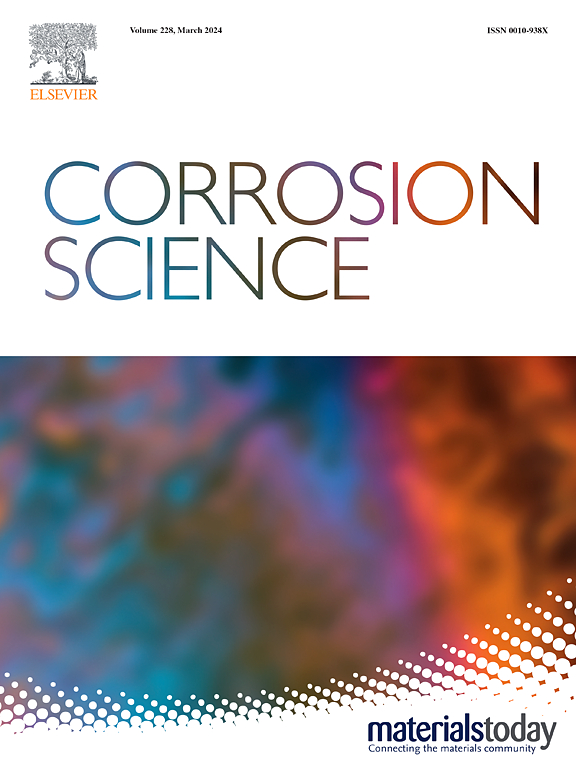不连续沉淀在Cu-Ni-Si合金腐蚀过程中的作用:钢筋和防火墙效应
IF 7.4
1区 材料科学
Q1 MATERIALS SCIENCE, MULTIDISCIPLINARY
引用次数: 0
摘要
传统上认为不连续析出加剧了合金的腐蚀,但其腐蚀行为尚不清楚。本文通过微观组织表征和电化学测试研究了不连续析出对Cu-5.0Ni-1.2Si合金腐蚀行为的影响。结果表明:在450℃时效4 h后,纤维状δ-Ni₂Si不连续析出形成,到8 h时占组织的一半左右,到12 h后几乎完全主导合金组织。其耐腐蚀性等级如下:12 h(0.163 mm·a⁻¹)>; 4 h(0.169 mm·a⁻¹)>; 8 h(0.182 mm·a⁻¹)。在腐蚀初期,不连续析出加速了Cu₂O的形成,促使腐蚀产物膜生长得更快、更厚。在后期阶段,较大尺寸的不连续析出物使其在膜内起到“加强棒”和“防火墙”的作用,抑制裂纹扩展和散裂,这对合金的耐腐蚀性有意想不到的贡献。本文章由计算机程序翻译,如有差异,请以英文原文为准。
The role of discontinuous precipitation in the corrosion process of Cu-Ni-Si alloys: Rebar and firewall effects
It is conventionally believed that discontinuous precipitation exacerbates alloy corrosion, but its corrosion behavior remains unclear. This work investigates the influence of discontinuous precipitation on the corrosion behavior of a Cu-5.0Ni-1.2Si alloy through microstructural characterization and electrochemical testing. The results demonstrate that fibrous δ-Ni₂Si discontinuous precipitation forms after 4 h of aging at 450°C, occupies approximately half of the microstructure by 8 h, and nearly fully dominates the alloy after 12 h. The corrosion resistance ranks as follows: 12 h (0.163 mm·a⁻¹) > 4 h (0.169 mm·a⁻¹) > 8 h (0.182 mm·a⁻¹). During the initial corrosion stage, discontinuous precipitation accelerates Cu₂O formation, promoting faster and thicker growth of the corrosion product film. In later stages, the larger dimensions of discontinuous precipitation enable it to act as "reinforcing bars" and "firewalls" within the film, inhibiting crack propagation and spallation, which has an unexpected contribution to the corrosion resistance of the alloy.
求助全文
通过发布文献求助,成功后即可免费获取论文全文。
去求助
来源期刊

Corrosion Science
工程技术-材料科学:综合
CiteScore
13.60
自引率
18.10%
发文量
763
审稿时长
46 days
期刊介绍:
Corrosion occurrence and its practical control encompass a vast array of scientific knowledge. Corrosion Science endeavors to serve as the conduit for the exchange of ideas, developments, and research across all facets of this field, encompassing both metallic and non-metallic corrosion. The scope of this international journal is broad and inclusive. Published papers span from highly theoretical inquiries to essentially practical applications, covering diverse areas such as high-temperature oxidation, passivity, anodic oxidation, biochemical corrosion, stress corrosion cracking, and corrosion control mechanisms and methodologies.
This journal publishes original papers and critical reviews across the spectrum of pure and applied corrosion, material degradation, and surface science and engineering. It serves as a crucial link connecting metallurgists, materials scientists, and researchers investigating corrosion and degradation phenomena. Join us in advancing knowledge and understanding in the vital field of corrosion science.
 求助内容:
求助内容: 应助结果提醒方式:
应助结果提醒方式:


